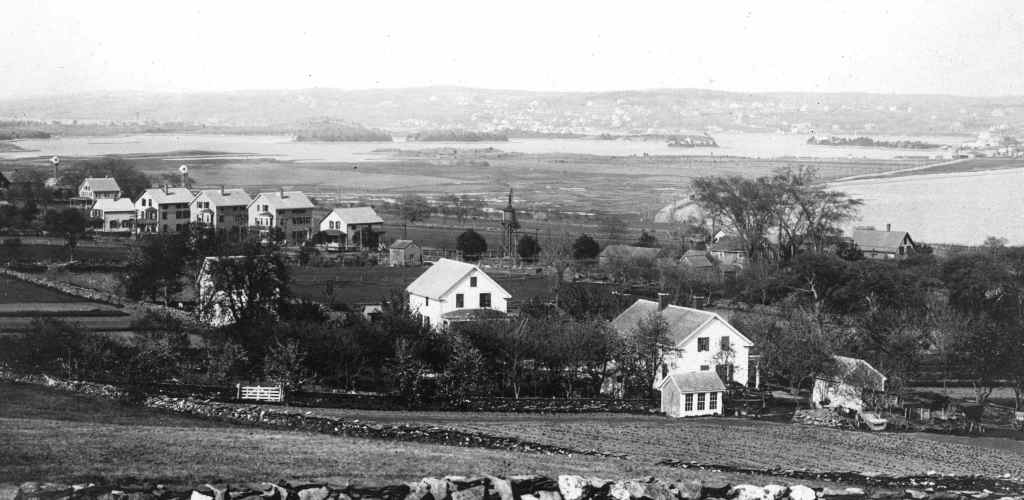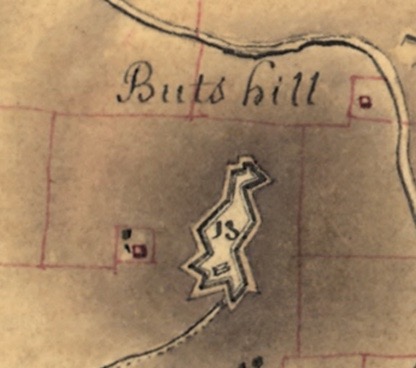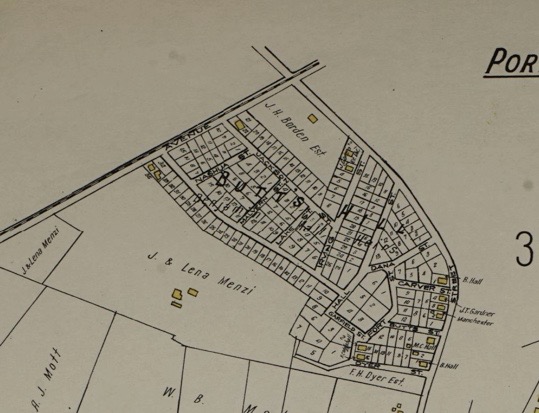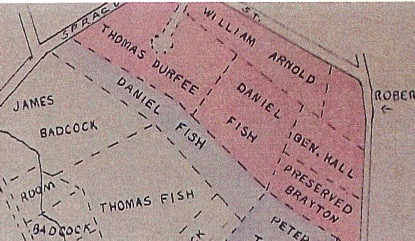During the War for Independence the hill that was known as Butts Hill or Windmill Hill became the location of Butts Hill Fort. The location provided a commanding view of the Eastern and Western sides of Aquidneck Island including East Main Road and West Main Road. It was a prime location for defensive fortifications.
1776 – Americans built small battery at Butts Hill.
1776 – December 8th. British occupation of island begins and American forces escaped via the ferries. British forces take over the battery at Butts Hill.
1777 -September: British General Pigot forced Portsmouth residents to work three days a week on the construction of the earthworks that remain today. Butts Hill Fort became the most important position because it guarded locations where Patriot forces might invade the island – Bristol Ferry, Common Fence Point, Howland’s Ferry and Fogland Ferry. It was a fortified barracks for up to 200 troops.
1778 – July 29th: The French fleet was expected in Newport so the British abandoned the fort to reinforce lines around Newport. American General Sullivan and his troops were waiting in Tiverton for an opportunity to cross to Aquidneck Island.
1778,- August 9 – 11th. On the morning of August 9th during a drill for the crossing, General Sullivan discovered that the British had abandoned fortifications at Ft Butts. He sent troops across because he knew the ferries were unguarded and they could cross safely. By August 11, American troops took over Butts Hill Fort.
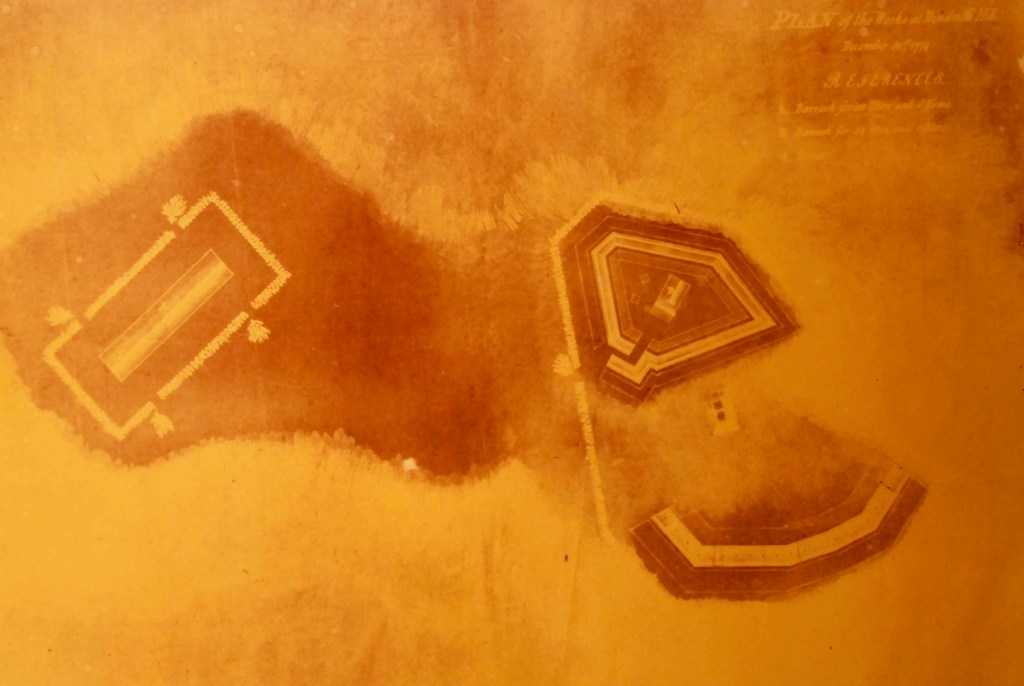
1778, August 20th, General Sullivan hears that the French fleet had gone to Boston for repair and resupply. The Americans were shocked by this news.
1778, August 24th. General Sullivan begins to make preparations for a retreat from the island.
1778, August 29-30th – Battle of Rhode Island. The British came after the American troops to prevent them from retreating from the Island. This battle came to be known as the Battle of Rhode Island. The heights of Butts Hill Fort provided the American Commanders with a view of the battlefield – Butts Hill, Quaker Hill and Turkey Hill. Although the Americans occupied the fort for only 17 days, it was their command post during the battle. The Americans successfully retreated.
1778, September 1st. The British return to Butts Hill Fort.
1779, October. British forces leave Butts Hill Fort and Aquidneck Island. The Americans again occupied the fort, and in the summer of 1780 they connected the redoubt and the former British barracks into one structure.
1780, July: The French arrived on Aquidneck Island. Before they had settled, there was news the British were planning to attack. Washington authorized Rochambeau “to call up the militia of Boston and Rhode Island to aid his army build the works for the defense of the island.”
The Black Regiment was split between guarding munitions in Providence and guard duty on Aquidneck Island. Sixty-four members of the regiment were sent to Newport and were incorporated into the “Rhode Island Six Months Battalion.” The Black Regiment veterans were among the 600 men encamped in Portsmouth guarding Butts Hill Fort, Howland Ferry and Bristol Ferry. One white recruit, Peter Crandall, wrote: “We landed on the north end of the island near Butts Hill Fort and pitched our tents on a height of land near Butts Hill Fort …. our duty was to go through the manual exercise, keep up quarter guard, and work on the fort.” This remnant of the Black Regiment and The Six Month Battalion were there until Nov. 1780. They remained at Butts Hill to work on the fort after the remainder of the Continental Battalion joined French troops in marching to join Washington’s army. **
1781, June: French troops leave Butts Hill Fort. Fort is abandoned. As Portsmouth recovers after the war, this land is unusable for agriculture and remains deserted.
1781, August: Five 18 pound guns with their carriages removed from Butts Hill to Easton Point
1783, June: RI assembly authorized sale at public auction of the gates, buildings and other installations
What happened to the land after the war is still somewhat of a mystery.
1850s Ward Map shows Butts Hill Fort, but no development of the land and no clear ownership. Butts family genealogy reveals that the Butts family moved away to Providence and other locations to practice their craft of rope making. They note that some of the land passes down through a daughter whose married name was Cook.
Civil War Era: There are reports that some militias use the fort for training purposes.
After the Civil War: Maps from the 1870s and 1885 clearly show the Fort as a prominent feature. During this time land evidence records show Charles Hicks Dyer and Charles Henry Dyer with ownership of the land around the fort. B. Hall Jr. also has a segment of Fort land.
1900: Notices appear in the newspapers for house lots for sale by Benjamin Hall Jr.
1908: The state of Rhode Island shows interest in making the land at Butts Hill Fort a state park.
1920s: Roderick Terry conveyed to Newport Historical Society, pieces of the land in 1923, 1924, and 1932.
Terry stipulated
- That the fort would serve as a memorial or monument to the memory of those who fought in the American-Revolutionary War.
- That said premises shall always retain the name of “Butts Hill Fort”.
- That said premises shall never be used to make money.
- That if the Newport Historical Society doesn’t take care of the fort, it would be transferred to the State of Rhode Island.
These provisions continue to control the property to this day!
1968 the State of Rhode Island transferred the property to Town of Portsmouth.
Sources:
Butts, Francis B. “The Butts Family of Rhode Island – Genealogy and Biography” 1891
McBurney, Christian. The Rhode Island Campaign. Yardley, PA, Westholme Publishing, 2011.
Dearden, Paul. The Rhode Island Campaign of 1778: Inauspicious Dawn of Alliance, Providence, Rhode Island Publications Society, 1980.
The French in Newport – Newport Historical Society, Fall 2003-spring 2004.
Neimeyer, Charles P. The British Occupation of Newport Rhode Island 1776–1779. Army History No 74, Winter 2010.
Abbass, D.K. “Butts Hill Fort” https://rhodetour.org/items/show/50
** Kopek, Daniel M. They “fought bravely, but were unfortunate:” The True Story of Rhode Island’s Black Regiment.
Bloomington, Indiana, AuthorHouse, 2015.
Reilly, James. Significance of Butts Hill in Portsmouth. July 1971 – Report submitted to the Rhode Island Historical Society.
